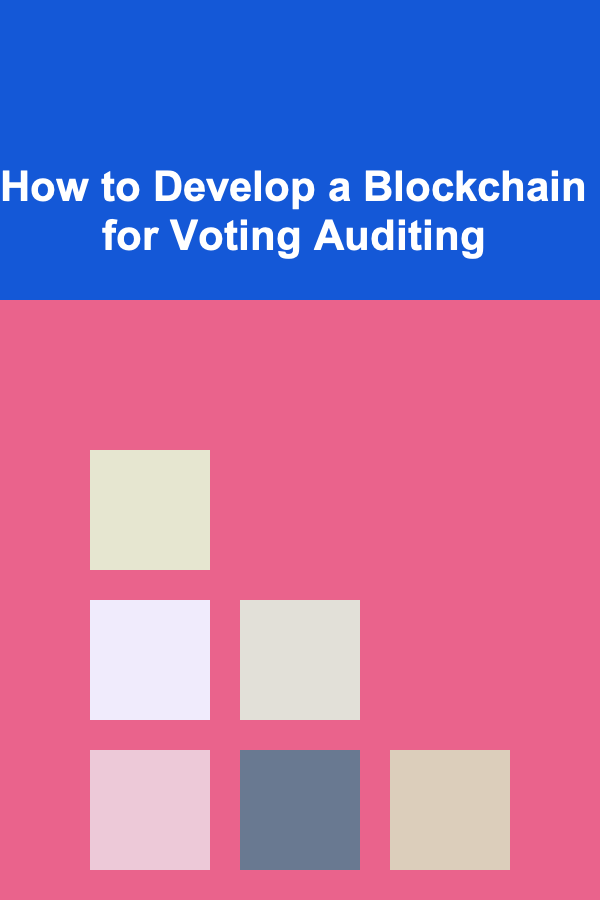
How to Develop a Blockchain for Voting Auditing
ebook include PDF & Audio bundle (Micro Guide)
$12.99$9.99
Limited Time Offer! Order within the next:

The concept of blockchain technology, once associated primarily with cryptocurrency, has evolved significantly in recent years. With its inherent features of decentralization, immutability, and transparency, blockchain has become a potential solution for a wide range of industries and applications. One of the most critical areas where blockchain can be applied is in the realm of voting and elections.
Voting systems worldwide have been subject to concerns over fraud, manipulation, transparency, and trust. In light of these concerns, developing a blockchain for voting auditing presents a promising opportunity to enhance the integrity of democratic processes. This article will explore the process of developing a blockchain-based system for voting auditing, its potential benefits, challenges, and the critical steps involved in building such a system.
What is Blockchain and Why is it Ideal for Voting Auditing?
Blockchain is a decentralized digital ledger technology that records transactions across multiple computers. These records are encrypted, timestamped, and linked together, making them immutable and tamper-proof. Due to the following characteristics, blockchain offers several advantages for voting auditing:
- Transparency: Blockchain allows every transaction to be publicly recorded, meaning that any voting activity can be traced and verified by any participant.
- Immutability: Once a vote is recorded on the blockchain, it cannot be altered or deleted, preventing fraudulent modifications of votes after they are cast.
- Decentralization: With no single point of failure, blockchain ensures that no central authority can manipulate or control the voting process.
- Security: Blockchain employs encryption methods, ensuring that data is stored securely and can only be accessed by authorized participants.
- Auditability: Blockchain enables continuous auditing, providing an immutable record that can be reviewed at any time to verify the integrity of the vote.
Given these features, a blockchain-based system could provide a powerful solution to ensure that votes are cast fairly, counted accurately, and auditable in real-time. The technology could help prevent election fraud, increase voter trust, and improve the overall transparency of the election process.
Key Components of a Blockchain-Based Voting Auditing System
Developing a blockchain for voting auditing involves several key components. Each component must be carefully designed to meet the specific requirements of the election process. Below are the critical components to consider:
1. Blockchain Protocol
The first step in building a blockchain-based voting auditing system is selecting the appropriate blockchain protocol. Blockchain networks can be broadly categorized into three types:
- Public Blockchains: Open to anyone and are fully decentralized. These are suitable for ensuring maximum transparency, as all participants can access the data.
- Private Blockchains: Restricted to a specific set of participants, providing more control over who has access to the network. Private blockchains are suitable for situations where voting data must be restricted to certain authorities or entities.
- Consortium Blockchains: A hybrid model where multiple organizations govern the blockchain network, often used for private applications like business partnerships. Consortium blockchains might be suitable for government-run elections where a coalition of institutions oversees the process.
In the case of voting auditing, a public blockchain could be the most suitable option, as it ensures full transparency and security. However, depending on the specific use case and legal requirements, a consortium or private blockchain may also be appropriate.
2. Smart Contracts for Vote Validation
Smart contracts are self-executing contracts with the terms of the agreement directly written into code. In the context of voting auditing, smart contracts can automate the validation process of votes, ensuring that votes meet the necessary conditions for being counted.
For example, a smart contract could:
- Verify Voter Identity: Ensure that only eligible voters are allowed to cast their votes, using mechanisms like digital IDs, biometric verification, or multi-factor authentication.
- Validate Vote Eligibility: Confirm that each vote is legitimate, non-duplicated, and cast within the defined election timeframe.
- Enforce Rules: Automatically apply rules governing the voting process, such as ensuring a voter can only cast one vote per election.
- Audit Results: Allow for automatic audits to be conducted by interested parties, ensuring the integrity of the election results.
3. Voting Mechanism (User Interface)
The voting mechanism is the front-end interface through which voters cast their ballots. It should be designed to ensure user-friendliness, security, and privacy. In a blockchain-based system, the voting interface can interact directly with the blockchain backend via a smart contract.
Key features of the voting mechanism should include:
- Authentication: Secure login options to verify the voter's identity.
- Vote Submission: A clear, easy-to-use interface for casting votes, which records them directly onto the blockchain once submitted.
- Voter Privacy: The system must protect voter anonymity, ensuring that votes cannot be traced back to individual voters. Techniques such as zero-knowledge proofs (ZKPs) can be used to verify that a vote is legitimate without revealing the voter's identity.
4. Auditing Tools and Analytics
Once the vote is cast, it is recorded on the blockchain and can be audited at any time by interested parties. To ensure that the election process is transparent and auditable, the system must include robust auditing tools that allow stakeholders to analyze the vote data effectively.
These tools should:
-
Provide a clear and accessible view of the votes cast.
-
Enable real-time monitoring and tracking of voting activity.
-
Allow external auditors to verify the integrity of the election process, ensuring that no votes have been tampered with or altered.
-
Present vote tallies in an easily understandable format, allowing stakeholders to validate the results independently.
5. Blockchain Infrastructure
The blockchain infrastructure refers to the underlying technical architecture that supports the voting system. This includes:
- Node Network: A distributed network of nodes (computers) that work together to verify and record transactions. Each node should follow the same set of protocols to ensure consistency across the network.
- Consensus Mechanism: A mechanism through which nodes in the network agree on the validity of transactions. Popular consensus algorithms include Proof of Work (PoW), Proof of Stake (PoS), and Practical Byzantine Fault Tolerance (PBFT).
- Data Storage: The blockchain stores a record of every vote cast, so it's crucial that sufficient storage capacity and security measures are in place to handle large volumes of data while maintaining data integrity.
Steps to Develop a Blockchain-Based Voting Auditing System
Developing a blockchain for voting auditing requires careful planning and execution. Below are the key steps involved in creating such a system:
1. Requirement Analysis
Before development begins, it's essential to conduct a thorough analysis of the requirements. This includes:
- Understanding the specific voting laws and regulations in the jurisdiction where the system will be used.
- Identifying the type of election (e.g., local, national, corporate) and the number of voters.
- Determining the key stakeholders involved, including government authorities, voters, and election observers.
2. Design Blockchain Architecture
The next step is to design the blockchain architecture. This involves choosing the appropriate blockchain platform (e.g., Ethereum, Hyperledger), defining the node structure, selecting the consensus algorithm, and deciding how data will be stored and processed.
3. Develop the Voting Interface
Developing the voting interface involves creating the front-end application where voters will interact with the system. This must be intuitive, secure, and accessible across multiple devices. The application should seamlessly integrate with the blockchain backend to record votes.
4. Implement Smart Contracts
Smart contracts will handle vote validation, eligibility checks, and enforcement of election rules. The smart contracts need to be carefully written and tested to ensure they perform as expected under all conditions.
5. Test the System
Before deployment, extensive testing is critical. This includes:
- Security Testing: Ensuring that the system is secure against hacking attempts and vulnerabilities.
- Performance Testing: Testing the system under high load conditions to ensure it can handle a large number of votes without crashing.
- User Testing: Ensuring that the voting interface is easy to use and meets accessibility standards.
6. Deployment and Monitoring
Once the system is developed and tested, it's ready for deployment. During the election process, the blockchain should be continuously monitored to ensure smooth operation. Additionally, real-time auditing tools should be available for external observers to ensure the integrity of the process.
7. Post-Election Auditing and Reporting
After the election, the blockchain can provide an immutable record of all votes, which can be audited by stakeholders. Reports can be generated to summarize the election process, vote totals, and any irregularities that may have been observed.
Challenges in Developing Blockchain for Voting Auditing
While blockchain offers significant advantages, several challenges must be addressed when developing a blockchain-based voting auditing system:
- Scalability: Handling large numbers of votes in real-time can put significant strain on the blockchain network. Efficient consensus algorithms and optimized data storage solutions will be necessary to ensure scalability.
- User Adoption: Voters may need training to understand how to interact with a blockchain-based voting system, especially if they are unfamiliar with digital technologies.
- Legal and Regulatory Issues: Governments may need to amend existing laws to accommodate blockchain-based voting, which could take time and political will.
- Privacy Concerns: While blockchain ensures transparency, it must also respect voter privacy. Ensuring that votes remain anonymous while still being verifiable presents a complex challenge.
- Infrastructure Costs: Setting up the necessary blockchain infrastructure, including nodes and storage, can be costly. Public and private organizations must be willing to invest in this technology to make it viable.
Conclusion
Blockchain has the potential to revolutionize the way elections are conducted and audited, providing greater transparency, security, and trust in the voting process. By developing a blockchain-based voting auditing system, governments and organizations can ensure that elections are fair, transparent, and tamper-proof.
While challenges remain, the advantages of blockchain in voting auditing---such as immutability, decentralization, and auditability---make it an exciting prospect for the future of democracy. As technology continues to evolve and the legal and technical hurdles are overcome, blockchain could become an integral part of election systems worldwide, ensuring that the voice of the people is heard and protected.
Reading More From Our Other Websites
- [Scrapbooking Tip 101] DIY Quote Cards: Step-by-Step Projects for Adding Personalized Words to Any Scrapbook
- [Home Soundproofing 101] How to Achieve Effective Soundproofing with Soundproof Underlayment for Your Floors
- [Personal Care Tips 101] How to Use Hair Serum for Silky, Soft Hair
- [Paragliding Tip 101] Riding the Sky: Mastering Thermal Soaring Techniques for Paragliders
- [Tie-Dyeing Tip 101] How to Master the Batik‑Style Tie‑Dye Technique on Linen
- [Organization Tip 101] How to Create a Travel Inventory for Your Luggage
- [Beachcombing Tip 101] Unexpected Gems: Unusual Items You Might Uncover While Beachcombing
- [Personal Investment 101] How to Start Building a Business Investment Portfolio
- [Ziplining Tip 101] From Grounded to Gliding: Personal Stories of Overcoming Vertigo on the Zipline
- [Organization Tip 101] How to Create a DIY Bathroom Organizer with Household Items

How to Create the Perfect Playlist for Any Home Party
Read More
How To Deal with Anxiety About School
Read More
How to Make Money Online as a Membership Site Owner
Read More
How to Monitor Your Investments and Adjust for Optimal Growth
Read More
How To Support Children's Positive Self-Concept
Read More
10 Tips for Using Blockchain to Enhance Supply Chain Transparency
Read MoreOther Products

How to Create the Perfect Playlist for Any Home Party
Read More
How To Deal with Anxiety About School
Read More
How to Make Money Online as a Membership Site Owner
Read More
How to Monitor Your Investments and Adjust for Optimal Growth
Read More
How To Support Children's Positive Self-Concept
Read More